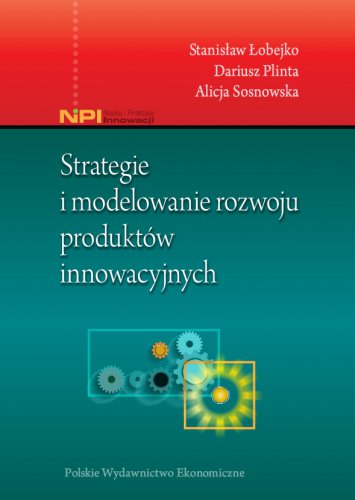Strategie i modelowanie rozwoju produktów innowacyjnych
Publication date: 2019
Place publication: Warszawa
Publication: I
Binding: paperback
Format: B5
A high rate of scientific and technological progress acts as one of the crucial factors of socio-economic development. Among other things, it has a great influence on enterprises operating in conditions of intense market competition. In order to be able to effectively compete on the global market, businesses should rely their development on new technologies and launch innovative products on the market. The book presents the most recent knowledge in the area of strategies and modelling of innovative products. It emphasizes a multi-faceted nature of innovations and discusses the key strategies and models of development of innovations. Also presented are methods of designing and modelling of innovative products.
The book is a great source of information for managers who intend to undertake activities aimed at launching of innovative products in the market. It may also be useful as a manual for students of all universities in which lectures in innovation management as well as strategies of innovative products development are delivered.
Wstęp
1. Zarządzanie innowacyjnym produktem
1.1. Wielowymiarowe ujęcie innowacyjnego produktu
1.2. Innowacyjne strategie rozwoju przedsiębiorstwa
1.3. Rozwój innowacyjnego produktu w strategii firmy
1.4. Cyfryzacja w strategii przedsiębiorstwa.
1.5. Kierunki rozwoju innowacyjnych produktów XXI wieku
2. Strategie rozwoju innowacyjnego produktu
2.1. Pojęcie i rodzaje strategii rozwoju innowacyjnego produktu
2.2. Miejsce strategii rozwoju innowacyjnego produktu w strategii rozwoju firmy – podejście projektowe
2.3. Rodzaje strategii rozwoju innowacyjnego produktu
2.3.1. Strategie według typu przedsięwzięć
2.3.2. Strategia niszy innowacyjnej
2.3.3. Strategia „błękitnego oceanu”
2.3.4. Strategie rynkowe rozwoju innowacyjnego produktu
2.3.5. Strategie marketingowe rozwoju innowacyjnego produktu
2.4. Strategie rozwoju innowacyjnego produktu wykorzystujące możliwości sieci
2.5. Wykorzystanie idei otwartej innowacji w strategii rozwoju innowacyjnego produktu
2.6. Modele budowy strategii rozwoju innowacyjnego produktu w korporacjach
2.6.1. Kompletny system innowacyjności od A do F
2.6.2. Strategia innowacji w Procter&Gamble
2.6.3. Strategia innowacyjnego produktu w Google
2.7. Strategie rozwoju innowacyjnego produktu w małych i średnich firmach
2.7.1. Różne modele strategii rozwoju innowacyjnego produktu. .
2.7.2. Strategia rozwoju innowacyjnego produktu w firmie Vigo System S.A.
2.7.3. Strategia rozwoju innowacyjnego produktu w firmie Escola
2.8. Strategie rozwoju innowacyjnego produktu w dziedzinie ekoinnowacji
2.8.1. Założenia wstępne
2.8.2. Przykłady strategii innowacyjnego ekoproduktu
2.9. Strategia rozwoju innowacyjnego produktu w firmach start-up
2.9.1. Wprowadzenie
2.9.2. Przykład strategii start-up w dziedzinie gier wideo
2.10. Tworzenie innowacyjnego produktu w małych i średnich przedsiębior¬stwach ulokowanych w Parku Naukowo-Technologicznym
2.10.1. Park Naukowo-Technologiczny (PNT) jako organizacja wspierająca innowacyjność przedsiębiorstw
3. Modele rozwoju innowacyjnego produktu
3.1. Teorie i modele rozwoju innowacji
3.1.1. Model podażowy
3.1.2. Model pętlowy
3.1.3. Model interaktywny
3.1.4. Model sieciowy
3.1.5. Model innowacji otwartej
3.2. Modele procesu rozwoju innowacyjnego produktu
4. Projektowanie rozwoju innowacyjnego produktu
4.1. Cykl rozwoju produktu
4.1.1. Badanie i poszukiwanie koncepcji
4.1.2. Założenia projektowe innowacyjnego produktu
4.1.3. Kształtowanie produktu
4.1.4. Modelowanie produktu.
4.1.5. Prototypowanie wirtualne i fizyczne
4.1.6. Przygotowanie produkcji i wytwarzanie
4.2. Techniki i systemy projektowania
4.3. Oddziaływanie zarządzania na innowacyjne projektowanie
5. Komputerowe modelowanie innowacyjnego produktu
5.1. Systemy komputerowe CAx
5.1.1. Wstęp do komputerowego wspomagania
5.1.2. Klasy systemów CAx
5.2. Modelowanie 2D w systemach CAD
5.2.1. Wprowadzenie do modelowania 2D
5.2.2. Reprezentacja obiektów graficznych
5.2.3. Sposoby wprowadzania koordynat punktów w układach współrzęd¬nych
5.2.4. Opis interfejsu użytkownika
5.2.5. Podstawowe obiekty rysunkowe i sposoby ich modyfikacji
5.2.6. Warstwy rysunkowe
5.2.7. Wymiarowanie
5.2.8. Rysunki prototypowe i tworzenie szablonów dokumentów
5.3. Modelowanie 3D w systemach CAD
5.3.1. Wprowadzenie do modelowania 3D
5.3.2. Modele szkieletowe
5.3.3. Modele siatkowe
5.3.4. Modele powierzchniowe
5.3.5. Modele bryłowe
5.3.6. Grafika prezentacyjna.
5.4. Zaawansowane modelowanie w systemie Autodesk Inventor
5.4.1. Wprowadzenie do projektowania w systemie Autodesk Inventor
5.4.2. Charakterystyka wybranych narzędzi wspomagających modelowanie produktu
5.4.3. Modelowanie adaptacyjnych części i zespołów produktu
5.4.4. Obiekty inteligentne
6. Przykład projektowania innowacyjnego produktu
Zakończenie
Bibliografia
Słownik ważniejszych pojęć
Indeks
| Odbiór osobisty | 0 € |
| Kurier Inpost | 4 € |
| Kurier FedEX | 4 € |
| Inpost Paczkomaty | 4 € |
| Free delivery in Reader's Club | from 47 € |

